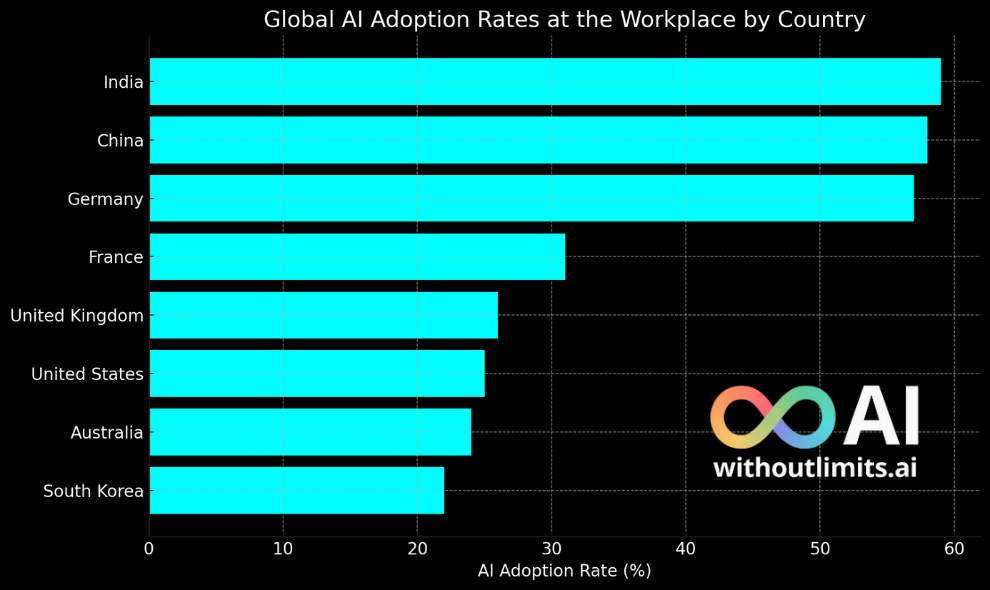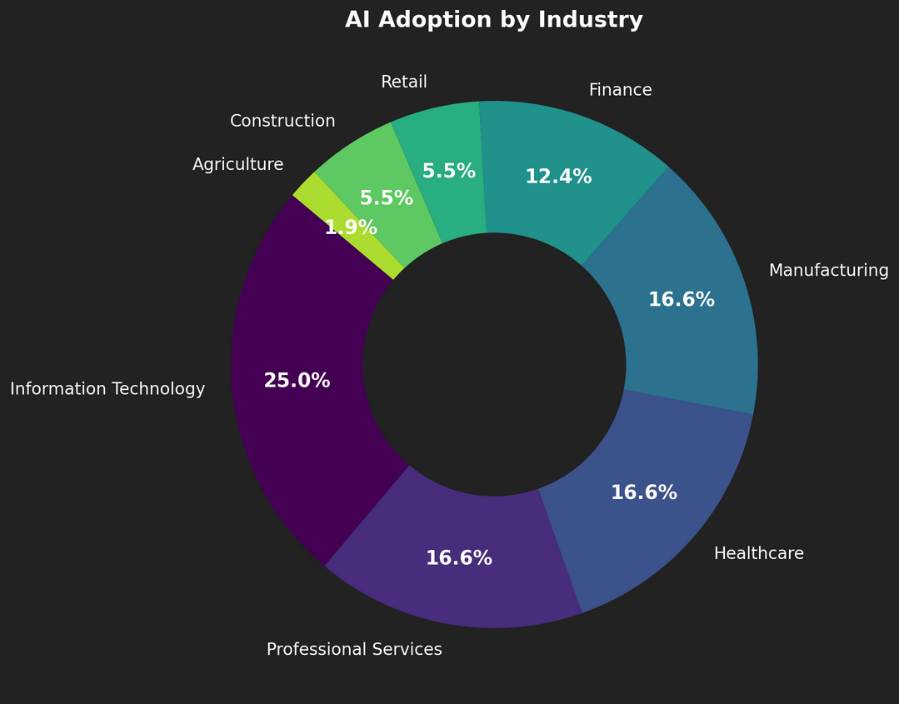Let me ask you something right off the bat: when was the last time you typed a report or wrote an email without Grammarly, ChatGPT, or some AI assistant chiming in with a better way to phrase it? Probably not recently, right? Whether you love it, fear it, or can’t decide yet, AI is quickly becoming part of our work lives—and that’s not changing anytime soon.
In this in-depth look, we’re pulling back the curtain on how AI is weaving itself into the modern workplace, who’s jumping on board, and what the next decade looks like in terms of jobs, fears, tools, and transformations. We’re talking real stats, human-level observations, and a few surprising truths.
Global AI Adoption Rates at Workplace by Country
Ever found yourself wondering, “Just how many folks are actually using AI at work these days?” Well, you’re not alone. I recently embarked on a quest to uncover the global landscape of AI adoption in workplaces, and let me tell you, the findings are as diverse as our world itself.
AI isn’t just a buzzword anymore; it’s becoming an integral part of our daily work routines. From automating mundane tasks to providing insights that drive strategic decisions, AI is reshaping the way we work. But how does this adoption vary across different countries? Let’s dive into the numbers.
📊 Comparative Table: AI Adoption Rates by Country
| Country | AI Adoption Rate (%) | Notes |
| India | 59% | Leading the pack with a robust IT sector driving AI integration. |
| China | 58% | Rapid advancements despite regulatory challenges. |
| Germany | 57% | Strong industrial base leveraging AI for manufacturing efficiencies. |
| France | 31% | Steady growth with emphasis on ethical AI practices. |
| United Kingdom | 26% | Significant uptick in AI usage, especially in finance and healthcare. |
| United States | 25% | Diverse adoption across sectors, with tech leading the charge. |
| Australia | 24% | Growing interest, though some skepticism remains. |
| South Korea | 22% | Focused on integrating AI in electronics and automotive industries. |
Source: Vention
🧠 Insights and Observations
- India & China: These countries are not just populous; they’re also powerhouses in AI adoption. With massive investments in technology and a burgeoning startup ecosystem, it’s no surprise they’re leading the charge.
- Germany: Known for its engineering prowess, Germany is effectively integrating AI into its manufacturing processes, enhancing productivity and precision.
- United Kingdom: The UK’s financial sector is increasingly relying on AI for risk assessment and fraud detection, while the healthcare industry explores AI for diagnostics and patient care.
- United States: While the tech industry is at the forefront, other sectors are gradually catching up, recognizing the potential of AI to streamline operations and drive innovation.
- Australia & South Korea: Both countries show promising growth in AI adoption, with targeted applications in specific industries like electronics, automotive, and mining.

AI’s integration into the workplace is not a uniform journey; it’s influenced by a country’s economic structure, technological infrastructure, and cultural attitudes towards innovation. As we continue to navigate this AI-driven era, it’s crucial for businesses and policymakers to understand these dynamics to harness AI’s full potential effectively.reuters.com
Top Industries Adopting AI in the Workplace
It’s no surprise that tech companies were the first to roll out AI. But today, healthcare, finance, and even farming are hopping on the AI train.
📊 AI Adoption Across Industries Table
| Industry | AI Adoption Rate | Key Use Cases | Source |
| Information Technology (IT) | 18.1% | Cybersecurity, data analysis, software development | GPTZero |
| Professional Services | 12% | Knowledge management, legal research, tax preparation | MIT Sloan |
| Healthcare | 12% | Diagnostics, patient data analysis, personalized treatment plans | MIT Sloan |
| Manufacturing | 12% | Predictive maintenance, quality control, supply chain optimization | MIT Sloan |
| Finance | 9% | Fraud detection, algorithmic trading, customer service chatbots | Business Insider |
| Retail | 4% | Inventory management, personalized marketing, customer service automation | MIT Sloan |
| Construction | 4% | Project planning, risk assessment, resource allocation | MIT Sloan |
| Agriculture | 1.4% | Crop monitoring, yield prediction, automated irrigation systems | GPTZero |
Did you know? In India, smart irrigation powered by AI is already saving millions of gallons of water every year.
🧠 Insights and Trends
- IT Industry: Leading in AI adoption, the IT sector utilizes AI for enhancing cybersecurity measures, analyzing vast datasets, and streamlining software development processes.
- Professional Services: AI assists in automating routine tasks such as document analysis and legal research, allowing professionals to focus on more strategic activities.
- Healthcare: AI applications in healthcare include diagnostic tools that analyze medical images and data to assist in early disease detection and treatment planning.
- Manufacturing: AI-driven predictive maintenance helps in anticipating equipment failures, thereby reducing downtime and maintenance costs.
- Finance: Financial institutions employ AI for real-time fraud detection, risk assessment, and enhancing customer interactions through chatbots.
- Retail: AI enables personalized shopping experiences by analyzing customer behavior and preferences, optimizing inventory, and improving customer service.
- Construction: AI aids in efficient project management by predicting potential risks, optimizing resource allocation, and ensuring timely project completion.
- Agriculture: Though adoption is currently low, AI has the potential to revolutionize agriculture through precision farming, optimizing resource use, and increasing crop yields.

As AI technology continues to evolve, its adoption across industries is expected to grow, offering opportunities for increased efficiency, cost savings, and innovation.
How Many People Are Using AI at the Workplace? GenZ, Millennials, GenX, Boomers
There’s a definite generation gap when it comes to comfort with AI. Gen Z grew up with it. Boomers? Not so much.
Table: AI Use by Generation in the Workplace (2024)
| Generation | % Using AI Tools Weekly | Common AI Use |
| Gen Z | 89% | Content creation, data analysis |
| Millennials | 77% | Project planning, communications |
| Gen X | 61% | Financial modeling, task automation |
| Boomers | 38% | Email assistance, calendar scheduling |
Source: Deloitte Digital Workers Survey 2024
Friendly banter: Ask a Gen Z how they organize their schedule, and they’ll probably say, “Google Bard does it for me.” Boomers, on the other hand, might still be using Post-It notes (no shame, though!).
How Much Are People Using AI at Work?
Not everyone uses AI the same way. Some folks automate half their day; others just ask ChatGPT for a better subject line.
Table: AI Usage Intensity in the Workplace (2024)
| Usage Level | % of Employees |
| Heavy (4+ hrs/day) | 22% |
| Moderate (1-4 hrs) | 47% |
| Light (<1 hr) | 25% |
| Never | 6% |
Source: Gartner AI Usage Study 2024
What Are the Most Common Reasons People Are Using AI in the Workplace?
AI is handy. People are using it to work faster, think smarter, and avoid burnout.
Table: Top Reasons for AI Use at Work (2024)
| Reason | % of Users Selecting It |
| Save time | 67% |
| Automate boring tasks | 61% |
| Generate content | 54% |
| Improve decision-making | 48% |
| Reduce errors | 42% |
Source: LinkedIn Workplace AI Insights 2024
Human touch: Let’s be honest—we all want to avoid the “death by spreadsheet” syndrome.
What Are the Most Common Fears About AI in the Workplace?
It’s not all sunshine and faster emails. People are worried—some with good reason.
Table: Workplace AI Concerns (2024)
| Concern | % of Employees Worried |
| Job loss | 58% |
| Privacy violations | 46% |
| Inaccurate AI output | 39% |
| AI bias or discrimination | 34% |
| Loss of human interaction/collab | 28% |
Source: Harvard Business Review AI Sentiment Survey 2024
Reality check: Being skeptical of AI isn’t Luddite behavior—it’s smart. We need guardrails.
What Are the Most Common AI Tools Used at Work?
It’s not all ChatGPT—though yeah, it’s high on the list. Here are the front-runners.
Table: Top AI Tools in the Workplace (2024)
| Tool | Primary Use | Popularity (%) |
| ChatGPT | Content writing, brainstorming | 64% |
| Grammarly AI | Editing, grammar checks | 58% |
| Midjourney | Visual content generation | 33% |
| Notion AI | Note-taking, planning | 29% |
| Jasper AI | Marketing copy, SEO | 22% |
Source: Zapier AI Tools Report 2025
Are Businesses Happy About AI in the Workplace?
Short answer: mostly yes. Long answer: It depends on who you ask.
Table: Business Satisfaction with AI Implementation (2024)
| Response Type | % of Businesses |
| Very satisfied | 36% |
| Somewhat satisfied | 41% |
| Neutral | 15% |
| Unsatisfied | 6% |
| Regret adopting AI | 2% |
Source: IBM AI for Business Survey 2024
Nuance: Some execs say AI helped them slash costs. Others say it created new complexities they weren’t ready for.
How Are Companies Planning to Adapt to AI?
Adaptation is the name of the game. You can’t just plug in AI and expect magic.
Table: Company Adaptation Strategies (2024)
| Strategy | % of Companies Doing It |
| Upskilling employees | 72% |
| Hiring AI specialists | 61% |
| Redesigning workflows | 58% |
| Investing in AI governance | 49% |
| Outsourcing AI tasks | 33% |
Source: Accenture Future of Work Report 2024
Empathy moment: A lot of companies are flying the AI plane while building it.
AI’s Effect on Jobs
AI is shaking up the job market—but not just in a “robots will take over” way.
Table: Job Types Affected by AI (2024)
| Job Type | AI Effect |
| Data entry | High risk |
| Software engineering | Augmented productivity |
| Customer service | Partial automation |
| Creative professionals | Enhanced output |
| Healthcare practitioners | Minimal disruption |
Source: World Economic Forum AI Impact Report 2024
Which Jobs Are Expected to See the Biggest Workforce Increases (2024–2034)?
Not all doom and gloom—some jobs are booming thanks to AI.
Table: Fastest Growing Jobs Due to AI (2024–2034 Projection)
| Job Title | Projected Growth (%) |
| AI Ethics Consultant | +41% |
| Prompt Engineer | +36% |
| Data Scientist | +34% |
| Machine Learning Engineer | +33% |
| AI Trainer/Labeler | +29% |
Source: BLS & Future of Jobs 2024
Which Jobs Are Expected to See the Biggest Workforce Decreases (2024–2034)?
And yes, some roles are winding down as AI steps in.
Table: Jobs Likely to Decline (2024–2034 Projection)
| Job Title | Projected Decline (%) |
| Data Entry Clerk | -38% |
| Telemarketer | -35% |
| Bank Teller | -28% |
| Travel Agent | -24% |
| Print Journalist | -21% |
Source: AI-Driven Agentification of Work: Impact on Jobs (2024–2030) LinkedIN
Final Thoughts
We’re in the thick of a historic shift. AI at work isn’t a phase—it’s a new fabric in the business wardrobe. But it’s not just about efficiency. It’s about rethinking how we collaborate, solve problems, and show up every day. AI can be a tool of liberation or stress—depending on how we choose to use it.
And the truth is, while AI may crunch numbers in milliseconds, it still can’t match your gut feeling, your quirky insights, or your office karaoke skills.
So the next time someone asks, “Is AI going to take our jobs?” maybe reply with, “Only the boring ones.”


